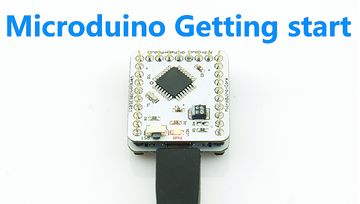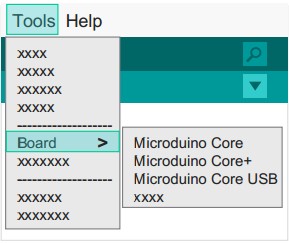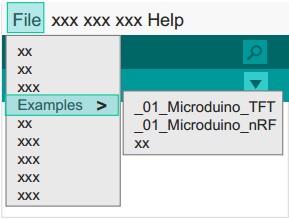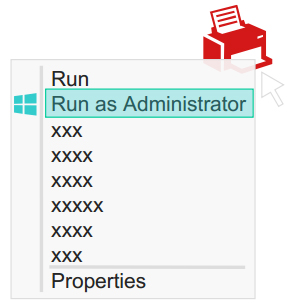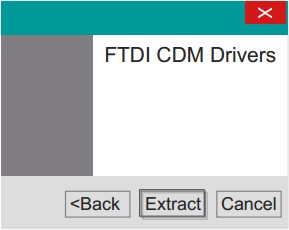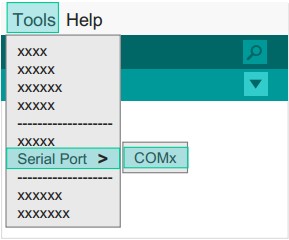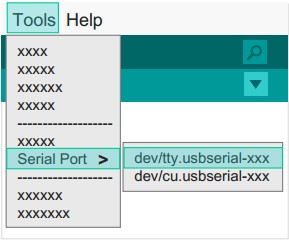Difference between revisions of "AVR Core: Getting Started"
From Microduino Wiki
| Line 1: | Line 1: | ||
| − | {{Language|Microduino | + | {{Language|Microduino Getting Started}} |
{| style="width: 800px;" | {| style="width: 800px;" | ||
| Line 75: | Line 75: | ||
'''*Windows'''<br> | '''*Windows'''<br> | ||
*Automatic installation | *Automatic installation | ||
| − | :1. Unzip get "\ Windows \ Automatic" folder contents | + | :1. Unzip get "\ Windows \ Automatic" folder contents. |
| − | :2. Run "CDM XX WHQL Certified.exe" as administrator | + | :2. Run "CDM XX WHQL Certified.exe" as administrator. |
| − | :3. Follow the prompts to complete the installation | + | :3. Follow the prompts to complete the installation. |
*Manual installation | *Manual installation | ||
:1. Advanced users may choose to install manually: | :1. Advanced users may choose to install manually: | ||
| Line 101: | Line 101: | ||
'''If there is damage or missing signature file when prompted, you need to disable the digital signature system installation in windows 8。''' | '''If there is damage or missing signature file when prompted, you need to disable the digital signature system installation in windows 8。''' | ||
1.Turn off the check. | 1.Turn off the check. | ||
| − | 2.Hold the shift key while clicking on Restart | + | 2.Hold the shift key while clicking on Restart. |
| − | 3.Select Troubleshoot > Advanced Options > Startup Settings > Restart | + | 3.Select Troubleshoot > Advanced Options > Startup Settings > Restart. |
4.After Restart select option 7. <br> | 4.After Restart select option 7. <br> | ||
by: [[http://answers.microsoft.com/en-us/windows/forum/windows_8-hardware/how-to-install-a-driver-that-does-not-contain/7c3f299b-3483-4c96-8c44-87c7451af222 Microsoft Answers]] | by: [[http://answers.microsoft.com/en-us/windows/forum/windows_8-hardware/how-to-install-a-driver-that-does-not-contain/7c3f299b-3483-4c96-8c44-87c7451af222 Microsoft Answers]] | ||
| − | ==Step 4: Connecting | + | ==Step 4: Connecting Hardware== |
| − | *Use Micro-USB cable to connect | + | *Use a Micro-USB cable to connect a Microduino-USBTTL to your PC / Mac: |
| Line 116: | Line 116: | ||
| | | | ||
'''*Windows''' | '''*Windows''' | ||
| − | + | :1. Open the IDE. Go to "Tools" > "Serial Port". | |
| − | + | :2. Select "COMXX". | |
|| | || | ||
[[File:microduinoGettingStart5.jpg|289px|right|thumb]] | [[File:microduinoGettingStart5.jpg|289px|right|thumb]] | ||
| Line 127: | Line 127: | ||
| | | | ||
'''*Mac OS''' | '''*Mac OS''' | ||
| − | + | :1. Open the IDE, in the menu "Tools" in the "Serial Port". | |
| − | + | :2. Select "dev / tty.usbserial-XX". | |
|| | || | ||
[[File:microduinoGettingStart6.jpg|289px|right|thumb]] | [[File:microduinoGettingStart6.jpg|289px|right|thumb]] | ||
| Line 139: | Line 139: | ||
*'''[[Install Arduino IDE Microduino Hardware Support Package]]''' | *'''[[Install Arduino IDE Microduino Hardware Support Package]]''' | ||
| − | *'''[[Install Arduino IDE Microduino | + | *'''[[Install Arduino IDE Microduino Library Support Package]]''' |
|} | |} | ||
Revision as of 17:09, 24 June 2015
| Language: | English • 中文 |
|---|
|
ContentsStep 1: Arduino IDE Download*Arduino compatible, first install the basic IDE
Step 2: Verify IDE
Step 3: Drivers*After the IDE is configured, install the drivers
Note: If there is damage or missing signature file when prompted, you need to disable the digital signature system installation in windows 8。 1.Turn off the check. 2.Hold the shift key while clicking on Restart. 3.Select Troubleshoot > Advanced Options > Startup Settings > Restart. 4.After Restart select option 7. Step 4: Connecting Hardware
Appendix |
